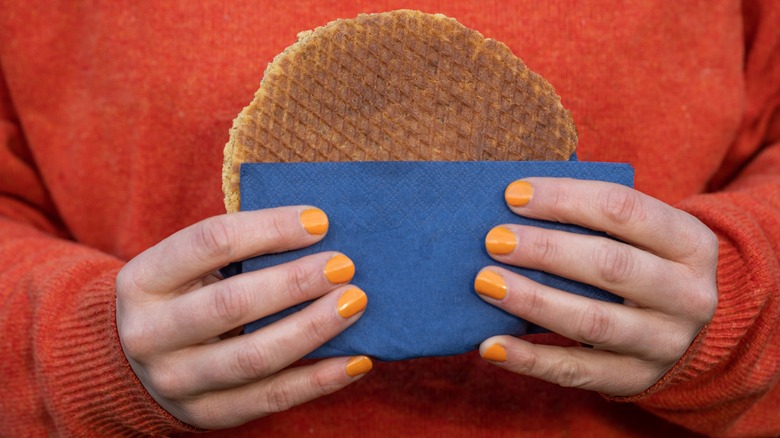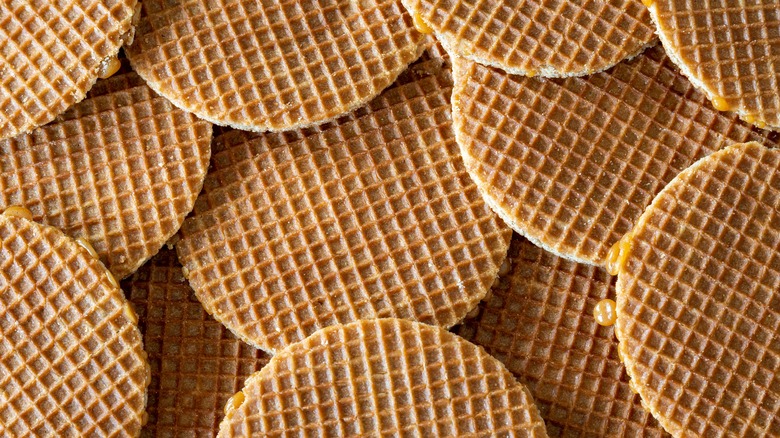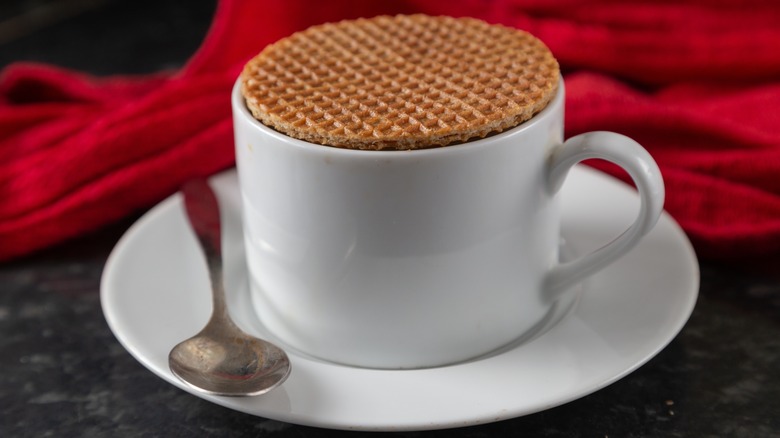The Folklore Behind Stroopwafel, The Netherlands' Most Iconic Treat
It may surprise you to learn that some of the world's most delicious treats were actually born out of resourcefulness. French toast was invented as a way to use up stale bread; banana bread as a way to utilize expiring fruit during the Great Depression; and almond croissants as a way to get rid of old or defective pastries (and it's a practice that is still, in fact, observed today). Another tasty dish that started life in this unexpected fashion is stroopwafel (pronounced "stroop-waa-fuhl").
Meaning "syrup waffle" in English, this Dutch cookie is so popular that its countrymen consume approximately 22 million packages of them each and every year. It's a traditional snack comprising two layers of thin and crispy waffle-like dough that sandwich a sweet cinnamon-spiked caramel — and it was originally cooked up as a way to put leftover and essentially unwanted ingredients to good use. Let's dive into the folklore surrounding the Netherlands' iconic treat.
From poor man's cookie to popular treat
It's thought the man responsible for introducing us to this waffle-y delight is Gerard Kamphuisen, a baker who hailed from Gouda — a city in the Netherlands also known for another famous food: Gouda cheese. He's said to have invented the cookie sometime around 1810 from breadcrumbs and other scraps at his bakery, to which he added syrup and formed a dough. This was then filled with more of the same syrup and cooked, resulting in a loose version of the stroopwafel we enjoy today. Earning the nickname armenkoeken (or, "poor man's cookies"), this was a deliciously humble treat with a price tag to match.
Skip forward almost 30 years, and Kamphuisen's creation was being pumped out by Gouda's very first stroopwafel factory. Another 40 years, and it was no longer a treat associated strictly with the lower classes, having spread its reach into homes all over the country. During this time, the cookie itself was also refined thanks to the modern waffle iron; this newly invented tool is what made it possible to bake a thinner, crispier version that not only featured stroopwafel's now-iconic crisscross pattern, but it also made the snack better suited to hold its signature filling.
At one point, stroopwafel was being manufactured by no less than 17 factories across Gouda; four of which are still around these days. Not bad for something that literally started out as scraps.
How to best enjoy stroopwafel
If you've yet to indulge in the deliciousness that is stroopwafel, you're in for a treat (think of it like a waffle ice cream cone, only round, and with a bonus filling). In the Netherlands, these cookies are traditionally placed over a cup of tea or other hot beverage to soften them up and melt the inside. For best results, the stroopwafel should be left to sit on the drink for at least a minute, before being flipped and the process repeated.
There are certainly other ways to enjoy these Dutch delicacies, however. Double down on the waffle cone theme and use them to wrap around a scoop of your favorite ice cream or gelato, a la an ice cream sandwich. Pretty much any flavor will work here, but vanilla, caramel, or anything containing cinnamon or pecans would pair particularly well with this treat's flavor profile. Alternatively, you could break some stroopwafel into chunks and serve it as a topping over scooped ice cream, banana splits, or ice cream sundaes. This could also be used to decorate cakes, brownies, and other bakes; or, sprinkle them over chocolate bark (again, think about complementary ingredients — a drizzle of salted caramel, candied nuts, or perhaps some pretzels).
You might even like to use stroopwafel in place of graham crackers the next time you make s'mores — just be sure to warm them through first to make them easier to eat. We reckon that's exactly the sort of resourcefulness that would make Gerard Kamphuisen proud.


